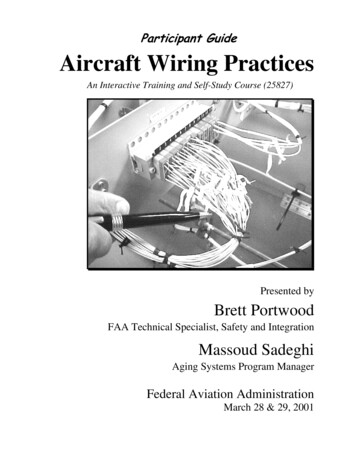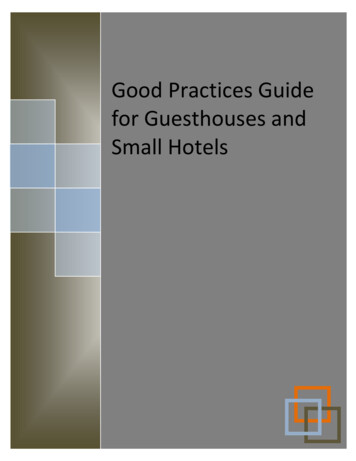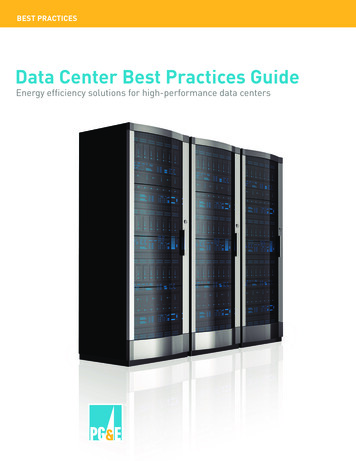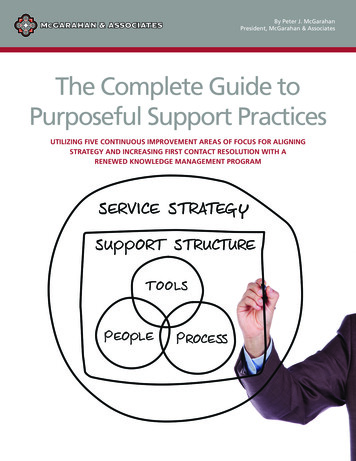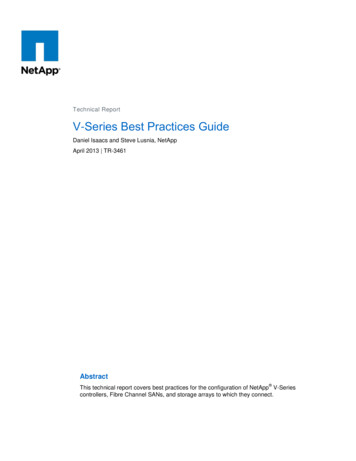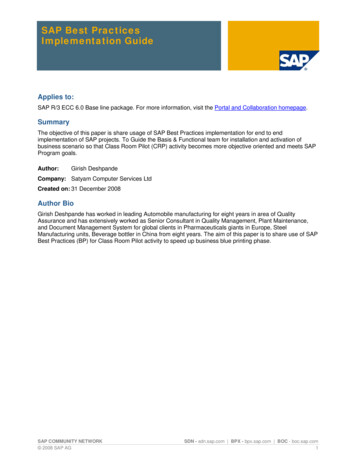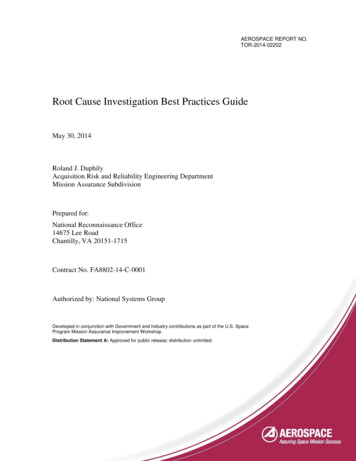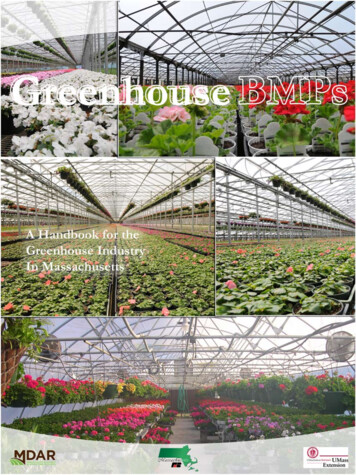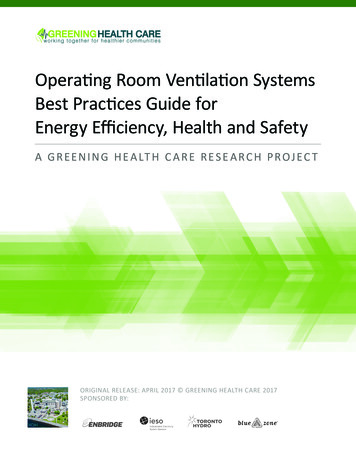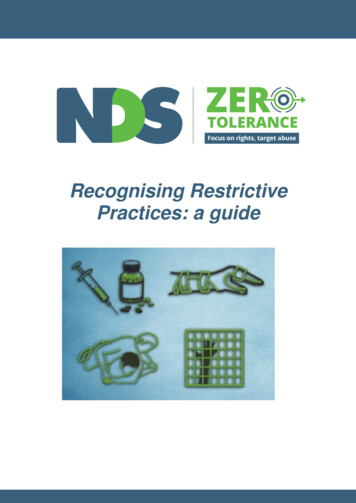
Transcription
Recognising RestrictivePractices: a guide
DisclaimerThe information provided in this guide is intended for general use only. It is not a definitiveguide to the law and best practice, does not constitute formal advice, and does not take intoconsideration the particular circumstances and needs of your organisation.Every effort has been made to ensure the accuracy and completeness of this document atthe date of publication. NDS cannot be held responsible and extends no warranties as tothe suitability of the information in this document for any particular purpose and for actionstaken by third parties.All stories used throughout this guide and these films are fictional and are for educationalpurposes only.CopyrightThis publication is copyright. All intellectual property rights vests in NDS. Material which isreproduced from this publication must include an acknowledgement of the source. Priorpermission should be sought from NDS. National Disability Services 2017Page 2
AcknowledgementsNational Disability Services would like to acknowledge the funding from the VictorianGovernment which allowed these Recognising Restrictive Practices resources to bedeveloped.We would also like to express our gratitude for the time and expertise given in thedevelopment of these resources by: Kerrie Hancox, Krysia Birman, Katie White and Bonnie O’Leary from the Departmentof Health and Human Services, Office of Professional Practice Associate Professor Paul Ramcharan and Dr Raelene West, RMIT University David Relf, Senior Positive Behaviour Support Practitioner, Yooralla Hayley Dean, Chief Operating Officer, Melba Support Services Dr Hilary Johnson, Strategic Research Project Advisor, Scope Jean-Marie Cadby, Actor, Fusion Theatre Company Greg Muir , Actor and Advocate, Weave Movement Theatre Members of the Recognising Restrictive Practices Project Reference Group Members of the Northern Territory Zero Tolerance Working Group and staff fromSomerville Disability Services Duy Huynh and the beyondedge team (www.beyondedge.com) NDS Learn and Develop: Nicole Jenkins NDS Zero Tolerance: James Bannister and Liz CollierWe would also like to say a very special thankyou to all the actors who brought thesecharacters and ideas to life on screen. Thank you!Page 3
About the Zero Tolerance initiativeZero Tolerance is an initiative led by NDS in partnership with the disability sector. Using ahuman rights approach, Zero Tolerance outlines strategies for service providers to improveprevention, early intervention and responses to abuse, neglect and violence experienced bypeople with disability. Put simply, Zero Tolerance means abuse is never OK. It urgesproviders to focus on rights and target abuse to create safer, more empoweringenvironments for people they support.An expanding range of Zero Tolerance tools and resources for the disability sector isavailable to support safeguarding approaches for people with a disability. See the NDSwebsite for more information: ut this guideThis guide accompanies the NDS Zero Tolerance Recognising Restrictive Practices films.You can use this guide to work through the films individually, with your team or – if you area supervisor – in supervision and training.The films and guide should be used in conjunction with your organisation’s policies andprocedures and any other expert bodies in your state or territory. Although specific policyand legislation varies depending on which state or territory you live and work in, these filmswill assist your team start conversations about restrictive practices and how people mightbe supported in different ways.Links to further information and resources are provided at the end of the guide.Page 4
IntroductionA Restrictive Practice is any practice ‘that has the effect of restricting the rights orfreedom of movement of a person with disability with the primary purpose of protecting theperson or others from harm’ 1. These practices can also be called restrictive interventions.Restrictive practices are often authorised for use as part of a person’s behaviour supportplan to make sure people can be supported safely.There are different rules across Australia about behaviour support plans, use of restrictivepractices, and who approves them. It is important to understand what rules apply in yourstate or territory and work with local experts to support people safely.Restrictive practices can also be overused or misused. They might be used: without the proper authorisation without knowing that something is a restrictive practice for too long and without being regularly reviewed for reasons other than keeping people safe to control people or to make people act in a certain way as a form of abuse and neglect due to a lack of training, knowledge or reflection about less restrictive alternativesRestrictive practices can have a serious impact on the health and wellbeing of people withdisability. This is one of the reasons why Australia has made a commitment to reducing andeliminating the use of restrictive practices for people with disability. The new NationalQuality and Safeguarding Framework will continue this work, and provide guidance for thedisability sector on finding more empowering ways to support people.This guide and accompanying short films have been developed as part of the ZeroTolerance Initiative to help explore restrictive practices from a human rights perspective.They will help you to think about what restrictive practices are and the impact they have onthe people you support. They will help you to explore less restrictive ways to support peoplesafely.1p4, National Framework for Reducing and Eliminating the Use of Restrictive Practices (2014)Page 5
About the filmsThe Recognising Restrictive Practices films have been developed for people who work inthe disability sector. They are designed to help you to recognise restrictive practices whenyou see or use them and start conversations about how to do things differently.There are seven topics, each with two films: Seclusion Chemical restraint Mechanical restraint Physical restraint Restricted access Power control Consequence controlPart 1 provides information about the restrictive practice and a scenario to be used forreflection and conversation. Part 2 shows people from different parts of the disability sectortalking about the scenario from a range of perspectives.For each topic, watch the scenario on your own or with your team. Then answer thefollowing questions: What did you observe? What impact do you think this has on the people involved? What would you question about this scenario? What could be done differently?Once you have finished, watch the second film to see what others have observed. Thinkabout how the points raised in the films relate to the people you support and discussanything that might be done differently in the future. In many situations, you might feel thatthe way a person is being supported is not right, but not be sure about what other optionsare available. Share ideas and knowledge within your team and think about where else youcan go for support and information.Page 6
Meet our characters:RayEmmaTomPennyJaiKimJordanLesleyCast and CrewEmmaJean-Marie CadbyJordanAdam BalalesTomAlex LitsoudisLesleyLisa DezfouliRayGreg MuirPennyMaria Thu FampidiJaiBenjamin OakesDirector Duy Huynh, Beyond EdgeKimKevin StantonPage 7
Restricted accessRestricted access is when a person is denied access to a room or part of their own home. Itis sometimes called ‘environmental control’ or ‘environmental restraint’.Examples of restricted access include: locked cupboards or fridges not being able to access your own possessions without permission rooms that are locked and can’t be accessed without permission not being able to access the community“Tom moves in”“The fridge stays locked.That’s the house rules”“Why? That’s weird”In this scenario we seeTom moves in to his new house. He tries to put his milk away in the fridge but finds it islocked. Lesley (the house supervisor) explains that the fridge is locked because anotherperson who lives in the house has a history of hiding food under her bed. Lesley tells Tom ifhe wants the fridge open, he just needs to ask. Later, we see Tom packing food and kitchenitems into a box to take back to his room.Things to talk about How do you think Tom feels about his new home? How would you feel? Are there any similar ‘house rules’ in place for anyone you support? Why? How comfortable are you to question restrictions that you don’t understand? How do you work with people to reduce the use of restrictions like this? How do you ensure that restrictions placed on one person do not impact on otherpeople?
SeclusionSeclusion is when a person is left alone in a room or space and they can’t leave, or theybelieve they can’t leave.Examples of seclusion include: being locked in a room or area and unable to leave being left alone in a room and believing you can’t leave being unable to leave a room or area due to inaccessible door handles“Working in the garden”“Jai, get out of the way or you’llhave to go back inside”In this scenario we seeTom, Emma, Jai, Greg and Jordan are in the garden, working and talking. Jai approachesTom and stands in front of him. Tom is not sure what Jai wants so he asks Jordan, thesupport worker, to intervene. Jai takes holds of the rake that Tom is using. Jordan tells Jaihe needs some time out and takes him inside away from the others. Later we see Jailooking through the window as everyone else carries on with the day.Things to talk about What do you think is happening for Jai? How do you think he is feeling? What could Jordan have done differently? Do you ever call ‘time out’ with people you support? Why does this happen? Are there people you support who don’t use words to communicate? What are somespecific actions you can take to better support people with different communicationneeds?Page 9
Chemical restraintChemical restraint is the ‘use of medication for the primary purpose of influencing aperson’s behaviour or movement’.2Examples of chemical restraint include: Use of psychotropic medications when behaviours may not be occurring over-medication or misuse of medication long term use of medication without a review to reduce the use of medication for thepurposes of behaviour management menstruation suppression“Penny and Kim”“ he’s just acting up and I’mway behind on my cleaning.”“But he’s not due for hismeds until 9pm ”In this scenario we seeKim is using his computer whilst Penny is cleaning. Penny accidentally turns the Wi-Fi off.Kim tries to let her know and get her attention but Penny thinks he is just ‘acting up’. Pennygets a phone call from someone who suggests she give Kim his night medication earlywhich she does. Kim falls asleep and Penny carries on with her cleaning.Things to talk about What would you do in Penny’s situation? Is this OK? Are there times when this is OK? Do you know what medication people are taking and why? What are the side effects? What is in place to ensure medication is only used as prescribed/regularly reviewed?2p5 National Framework for Reducing and Eliminating the Use of Restrictive Practices (2014)Page 10
Physical restraintPhysical restraint is ‘sustained or prolonged use of physical force to prevent, restrict, orsubdue movement of a person’s body or part of body [for] influencing behaviour’3Examples of physical restraint include: Pinning someone down to stop them acting in a certainway or to change their behaviour Holding a person’s arms or legs to stop them moving“Movie night”“I’ve never seen him like this before.”“He’s been doing this a lot lately. I justhave to hold his hands until he calmsdown ”In this scenario we seeKim and Penny are visiting Tom in his new house. Whilst the group watch a movie Kimseems to hit himself in the face repeatedly. Tom and Jordan worry about Kim. Penny tellsthem that he has been doing this a lot lately, and that she just holds his hand down until hefeels better. Penny pushes Kim’s arm down and holds it on his tray.Things to talk about What are some of the reasons why Kim might be hitting himself? Is Penny helping ormaking things worse? How do you decide how to support someone who tries to harm themselves? What systems do you have in place to record changes in behaviour and share thisinformation with staff and other relevant professionals?3p5 National Framework for Reducing and Eliminating the Use of Restrictive Practices (2014)Page 11
Power controlPower control is where a person uses their position of power or authority to control anotherperson’s behaviour or make them do something.Examples of power control include: being told not to move or to speak being told to sit down treating adults like they are children“Dinner time”“Hands on your laps, everyone”“We are not kindergartenpeople.”In this scenario we seeTom has made souvlaki for his new housemates. Everyone sits down to eat at the table.Tom is about to start eating but Emma stops him. Jordan explains that they must wait untileveryone is ready to start eating. Lesley tells everyone to put their hands in their laps. Tomis surprised at the way everyone is being treated but Emma is used to it.Things to talk about How do you feel watching this film? Who do you think makes the rules in this house? Have you even seen any power imbalances like this in your job? How did you feel?What did you do? How do you support people to choose how they want their lives to be?Page 12
Consequence controlConsequence control is when someone uses warnings, threats or intimidation to makesomeone do what they want them to do.Consequence control often involves threats about things, people oractivities that are important to the person. Examples include: personal threats involving relationships or possessions coercion or bribery punishment or implication of punishment“Out for lunch”“Do you want me to call yourbrother and tell
Penny Jordan Lesley Cast and Crew Emma Jean-Marie Cadby Tom Alex Litsoudis Ray Greg Muir Jai Benjamin Oakes Kim Kevin Stanton Jordan Adam Balales Lesley Lisa Dezfouli Penny Maria Thu Fampidi Director Duy Huynh, Beyond Edge. Restricted access Restricted access is when a person is denied access to a room or part of their own home. It is sometimes called ‘environmental control’ or .


